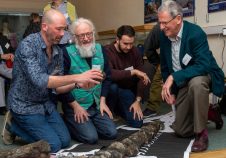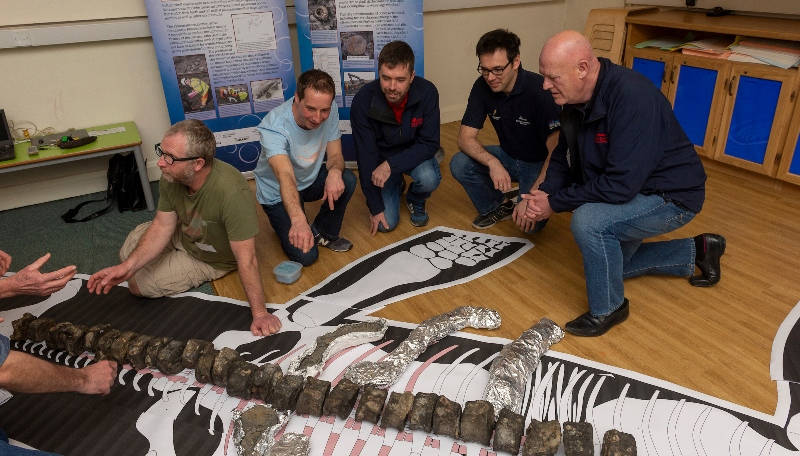Andy the Pliosaur lived over 155 million years ago and died on land operated by CEMEX in North Lincolnshire, buried deep among the clay.  About 18 months ago the first of Andy’s bones were discovered by a member of the Stamford and District Geological Society, Darren Withers. With the help of the Site Manager, Andy Schofield, 29 vertebrae, a tooth, 14 ribs, humerus (bone of the upper forelimb) and some of the small bones from the tip of the upper jaw, premaxilla were found by Darren and a team of amateur geologists led by one of the country’s leading Pliosaur experts Richard Forrest. “Although the specimen is not complete it tells a fascinating story of how the carcase was broken down by scavenging and decay in the ancient Kimmeridge Clay seas. Because top predators are much less common than their prey, this is indeed a rare find. We have hundreds of specimens of other marine reptiles but only a handful of Pliosaurs,” comments Richard. “And of course, it had to be named after Andy who along with CEMEX were instrumental in helping us find this amazing specimen.”
About 18 months ago the first of Andy’s bones were discovered by a member of the Stamford and District Geological Society, Darren Withers. With the help of the Site Manager, Andy Schofield, 29 vertebrae, a tooth, 14 ribs, humerus (bone of the upper forelimb) and some of the small bones from the tip of the upper jaw, premaxilla were found by Darren and a team of amateur geologists led by one of the country’s leading Pliosaur experts Richard Forrest. “Although the specimen is not complete it tells a fascinating story of how the carcase was broken down by scavenging and decay in the ancient Kimmeridge Clay seas. Because top predators are much less common than their prey, this is indeed a rare find. We have hundreds of specimens of other marine reptiles but only a handful of Pliosaurs,” comments Richard. “And of course, it had to be named after Andy who along with CEMEX were instrumental in helping us find this amazing specimen.”
 Pliosaurs were marine reptiles, not dinosaurs. They were the top predators of
Pliosaurs were marine reptiles, not dinosaurs. They were the top predators of  the seas and the specimen found would have been a creature of over 8 metres long and 4 metres wide. According to today’s experts, Pliosaurs dominated the seas for around 75 million years, had an enormously powerful bite, complex system of sensory organs in their snouts, great eyesight and the ability to taste water as they swam to locate prey. No wonder they were top of the food chain!
the seas and the specimen found would have been a creature of over 8 metres long and 4 metres wide. According to today’s experts, Pliosaurs dominated the seas for around 75 million years, had an enormously powerful bite, complex system of sensory organs in their snouts, great eyesight and the ability to taste water as they swam to locate prey. No wonder they were top of the food chain!
Andy the Pliosaur is going on temporary exhibition at the North Lincolnshire Museum in Scunthorpe.
